This video shares a virtual reality based performance at a corporate event in Las Vegas. The tools used included the Oculus Rift and Google Tilt Brush.
Reactions:
“…energetic, innovative and exciting!”
“…terrific, looked wonderful.”
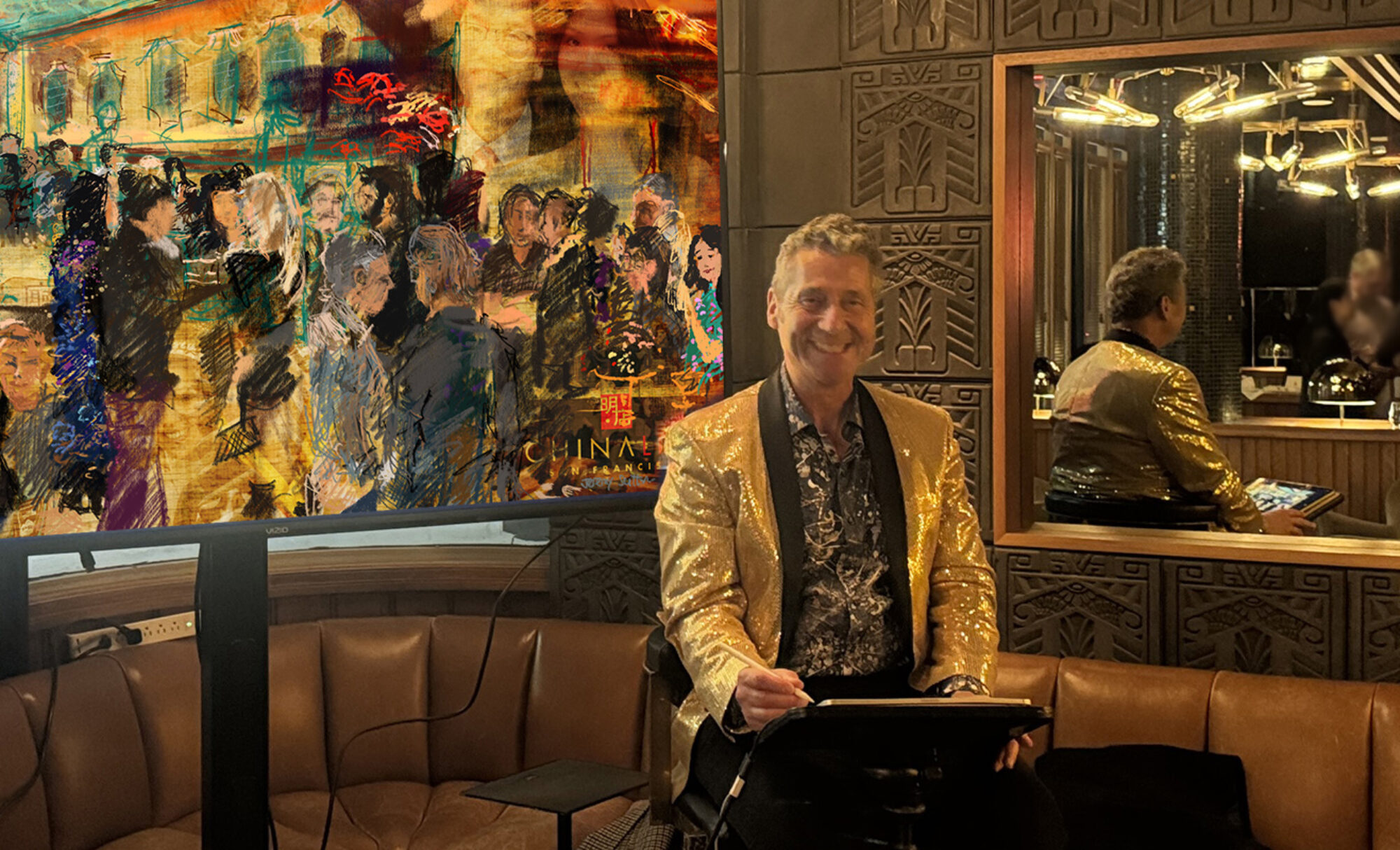
This web site features the art of Live Event Painter Jeremy Sutton.
This video shares a virtual reality based performance at a corporate event in Las Vegas. The tools used included the Oculus Rift and Google Tilt Brush.
Reactions:
“…energetic, innovative and exciting!”
“…terrific, looked wonderful.”

Jeremy Sutton, Ying Quartet at Kohl Mansion, 2017, iPad Pro, Apple Pencil, Procreate
This drawing was created on February 12th, 2017, from life during a concert of the Ying Quartet at the historic Kohl Mansion, part of the Music at Kohl Mansion program. This drawing was created in the second half of the concert when they played Beethoven’s String Quartet in C Major, Op. 59, No. 3, “Ruzumovsky”.
Replay video showing how the drawing progressed from start to finish.My Spring Open Studios Art Exhibition was part of a weekend where hundreds of artists open up their studios to the public throughout the Mission district in San Francisco (Mission Artists United web site). Within the historical industrial building in which my studio is located, 1890 Bryant Street Studios, around 70 artists showed their work. I showed my latest creations, digital and non-digital, ranging from live iPad portraits and drawings of musicians to traditional figure drawings and an on-going acrylic portrait (the Friday night reception live demo performance shown above). Each day of the show I created a live iPad portrait of a visitor. Here are the three portraits.
iPad sketch of Armistead (iPad Pro, Apple Pencil, Procreate) Armistead being drawn
Armistead being drawn
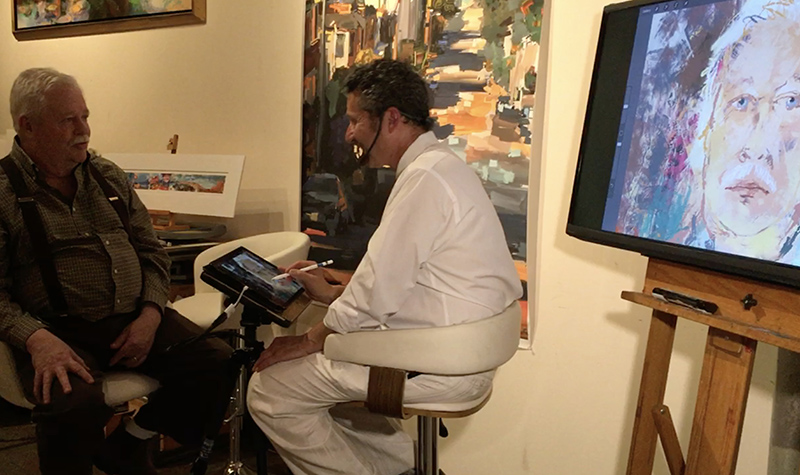
 Rachael being drawn
Rachael being drawn
 Leece being drawn
Leece being drawn
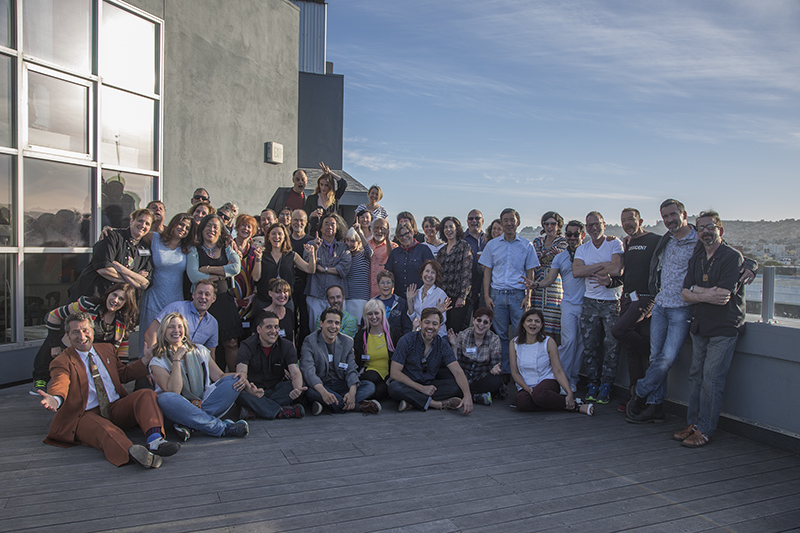 Great group of artists in our building!
Great group of artists in our building!
Below is an iPad sketch I’d made earlier of Sarah playing the harp:
 Jeremy working on his painting of Shahasp in a live art performance to the musical accompaniment of harpist Sarah Lamb (photography by Jay Cunanan)
Jeremy working on his painting of Shahasp in a live art performance to the musical accompaniment of harpist Sarah Lamb (photography by Jay Cunanan)

48″ x 48″, acrylic on canvas
Available for sale $12,000 (contact Jeremy to purchase)
I invited Shahasp to participate in an open-ended collaborative creative project. I wanted to work on a traditional media portrait slowly over time, in contrast to most of my very fast digital work. I took the time to work on this slow projects on a regular basis, roughly once a week for about two hours, without a deadline, without the pressures of a commissioned artwork, without trying to please anyone, and with open expectations and a willingness to take risk. The only boundary condition I set myself was the commitment that every mark I make during the entire process is made from direct observation while my model is sitting in front of me. No photographic reference was used. This artwork ended up taking about ten months, starting August, 2016, and ending March, 2017. Click here if you’d like to see the next “slow project” I am working on with Shahasp, this time on paper.

Jeremy working on his painting of Shahasp in a live art performance to the musical accompaniment of harpist Sarah Lamb (photography by Jay Cunanan)
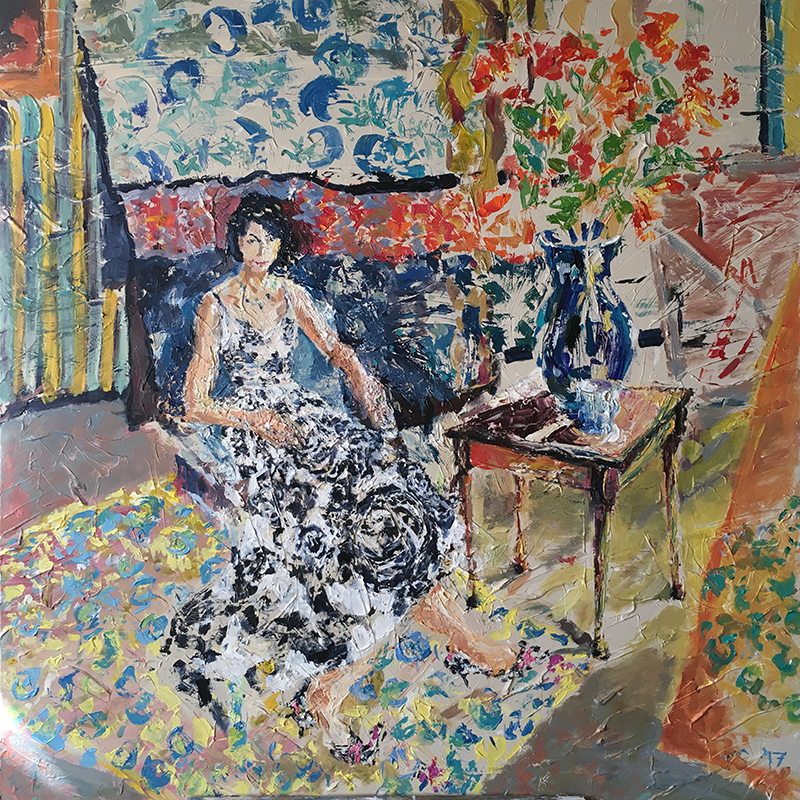
This painting, plus some of the preparative studies, were displayed at my Open Studios exhibition, March 31st – April 2nd, 2017, which included a live demo working on the portrait with Shahasp sitting in person. Last Thursday I went to see the fabulous Matisse/Diebenkorn exhibition at SFMOMA and was definitely influenced and inspired by what I saw there as I worked on the portrait today. May have overdone the thick black lines, but can always transform those later. Added some geometric elements (verticals, diagonals, blocks and so on) in the corner areas that had been a little neglected up to now. That’s a corner of my canvas itself now showing in the lower right (picture within picture)…Feel that the artwork is starting to transition from a sketch or study to an actual painting… Still lots to do!!


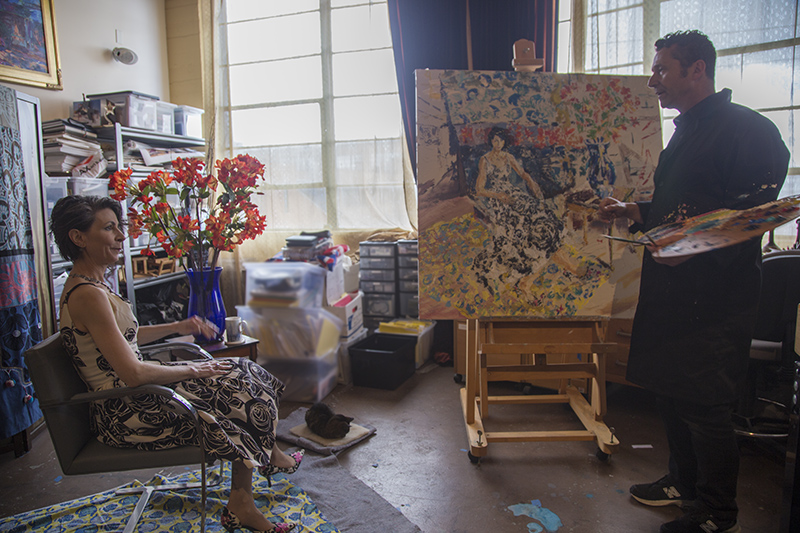
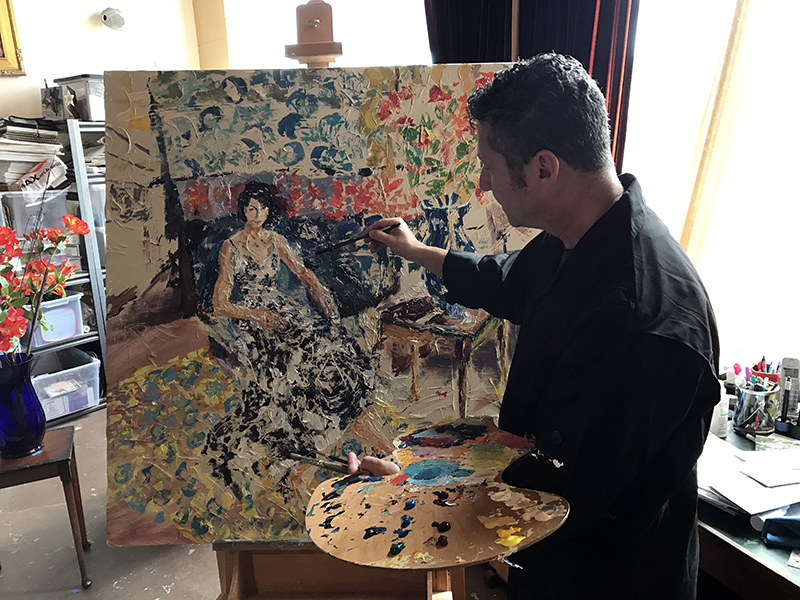







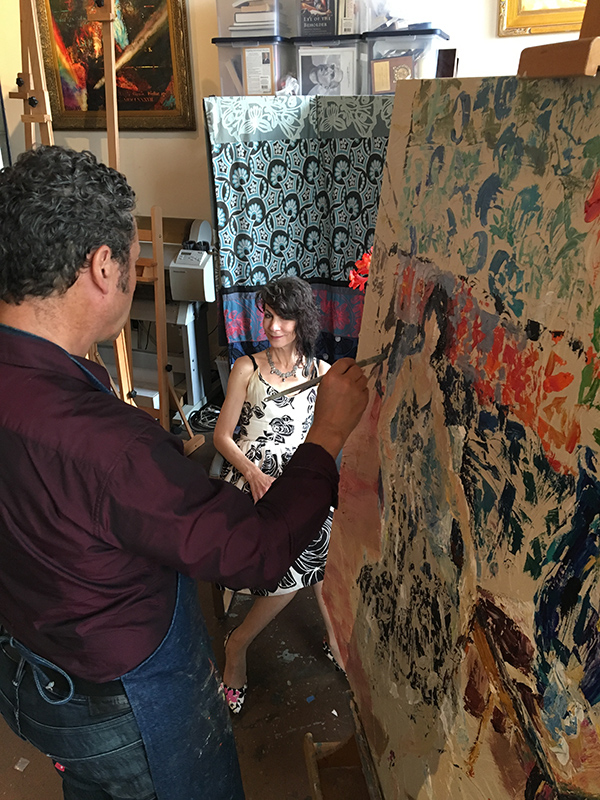

Starting to work into the shapes. Taking a month long break (actually six weeks) and then taking a fresh look really makes me realize all the things not working! As I moved around the canvas with my palette knife I realized how much my view of the scene changes, even with just a few feet of movement. That constantly changing perspective is also what I love about drawing/painting from life – it’s a variety of views that no single photograph could ever capture. Working from a flat photo could never approach the movement and change in painting from life. My changing view of my subject as I move is challenging yet also refreshing! I also noticed the different light coming through the window and how it highlighted the scene in such different way to a month ago: the sun now lower in the sky as we transition from autumn to winter…
~ Jeremy
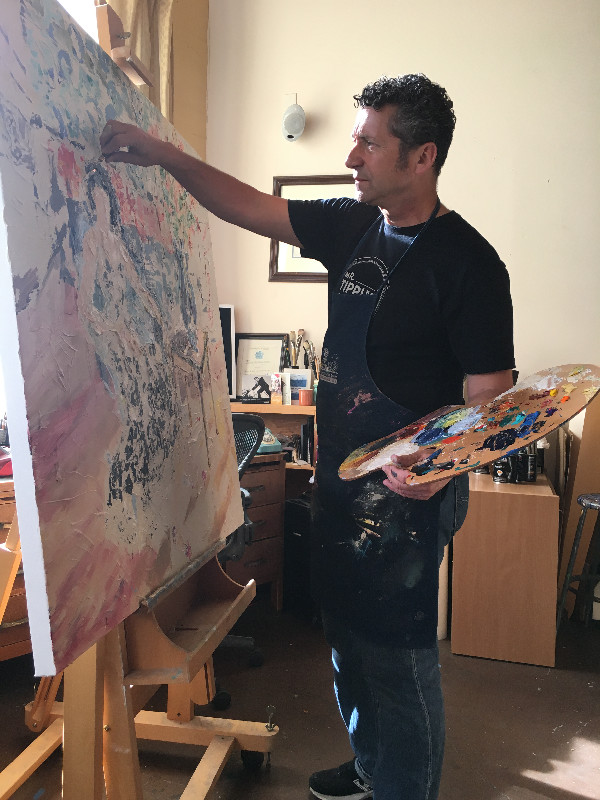
November 28th, 2016

48″ x 48″ acrylic on canvas

48″ x 48″ acrylic on canvas
One of my favorite parts of this process of sitting for a portrait is the evolution of it…how unexpected the portrait is. Each week I’m delightfully surprised by what unfolds. I love the depth of the texture and how much it lends itself to the character of the whole painting. I love the bright colors!
~ Shahasp
I love this process.. the voyage of discovery, of allowing the journey to flow and accepting the unexpected turns and twists along the way. I love the commitment to the journey.. an open-ended exploration and creation. I love getting to know my subject, Shahasp, better with each sitting.
~ Jeremy
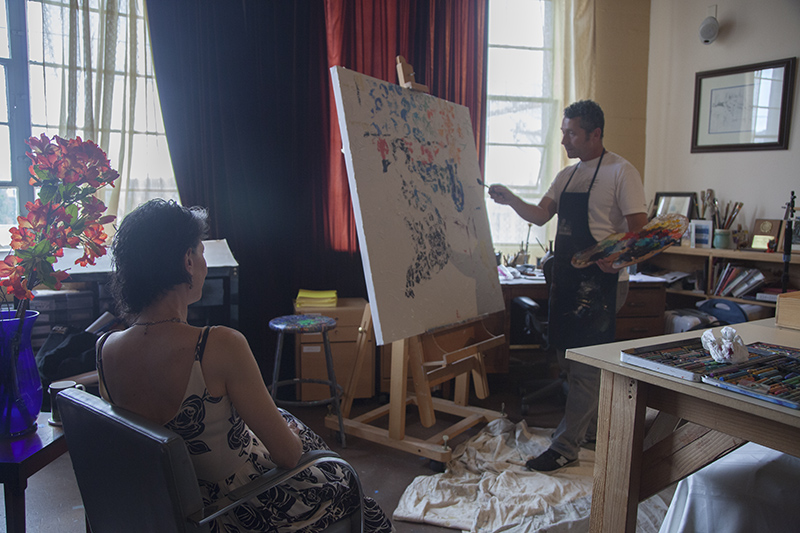
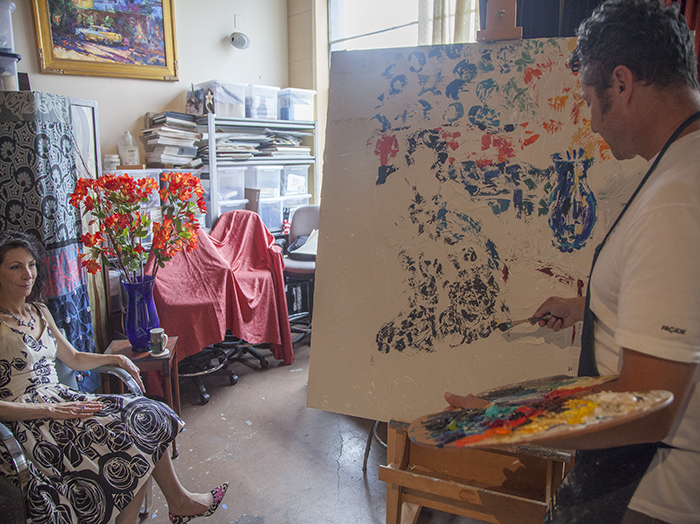


48″ x 48″ acrylic on canvas
I knew texture was very important to me in this artwork. I decided to create my ‘ground’ with thick palette knife application of Titan Buff acrylic paint. As I applied the paint I looked at my subject and essentially painted the entire scene in impasto textural relief. I liked how it looked without any color – I could see the whole composition in the light and shadow of the texture. As an unexpected side product it was also a fabulous surface to capture for my iPad backgrounds!
~ Jeremy

48″ x 48″ graphite on paper
I decided on 48×48. It just felt right. My next step once I’d made that decision was to work on the compositional decisions: what scale to place Shahasp within the edges, where to place her vertically and horizontally, what symmetry/asymmtery to work with and what to have flowing off, and cut off by, the edges of the composition?
~ Jeremy

24″ x 36″ acrylic ink on canvas
The studies led into working on a 24 x 36 stretched canvas. I was inspired by the wonderful colors, shapes and patterns of Matisse’s work. I soon found, though, that I felt cramped in the space on the canvas, both with respect to overall dimensions as well as with regard to the aspect ratio. I knew I needed to work bigger! This 24 x 36 study is available for purchase for $6,500 (contact Jeremy to purchase).
~ Jeremy

18″ x 24″ oil stick and pencil on paper
I started with drawing a couple of quick studies on 18 x 24 paper. This helped me get to know my subject and my composition…
~ Jeremy

18″ x 24″ pencil on paper

On March 4th, 2017, I sketched live on the 6K video screen in the Forum area of the beautiful new Apple Union Square in San Francisco, one of the early Today at Apple featured artists at that location. I used the iPadPro, Apple Pencil and the Procreate app.
I created two live artworks at this event, the first a depiction of the scene looking out through the magnificent large (two storeys high!!) windows onto Union Square, and the second a portrait of one of the visitors to the store that afternoon, Victor who was visiting from New York City. Thank you to the Apple team for inviting me to draw live on their wonderful 6K video wall and share my process with their visitors. It was great to see everyone just pick up an iPad and start sketching! Thanks also to Sumit and Caroline (co-founders and co-organizers of the annual mobile Digital Art & Creativity Summit in Palo Alto where I have been a speaker the last three years) for the I (heart) mobileart t-shirt I wore for this event!
Here (below) are the final artworks plus some photos and videos of the scene to give you an idea of the atmosphere.

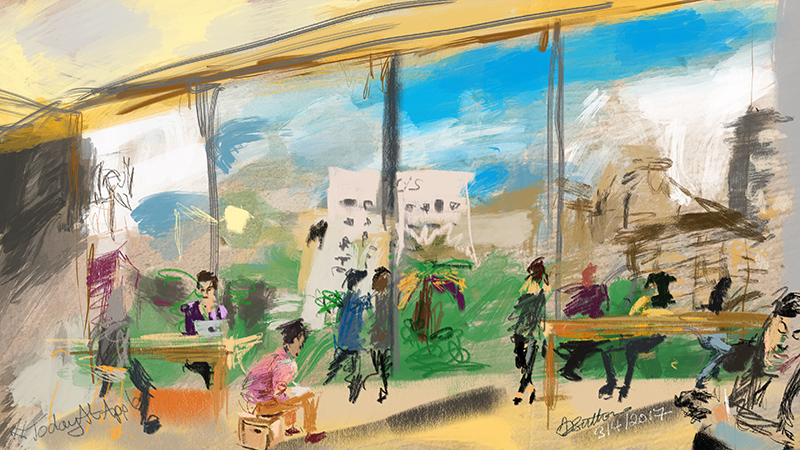

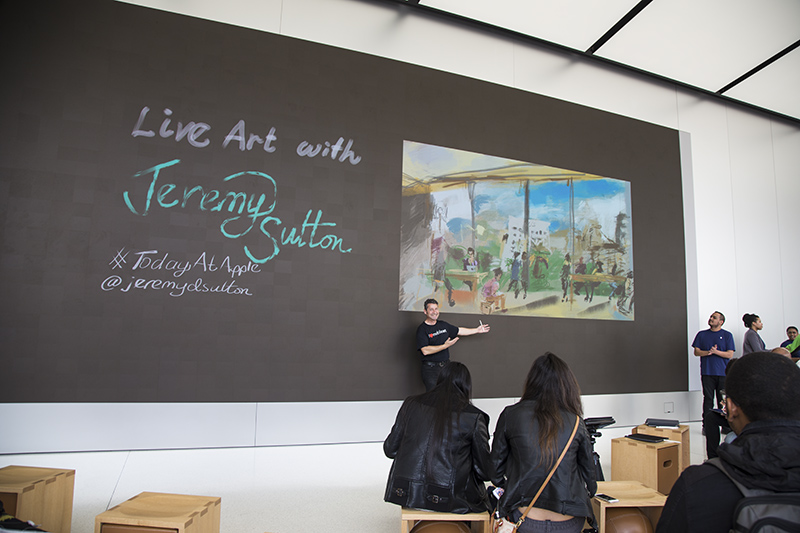
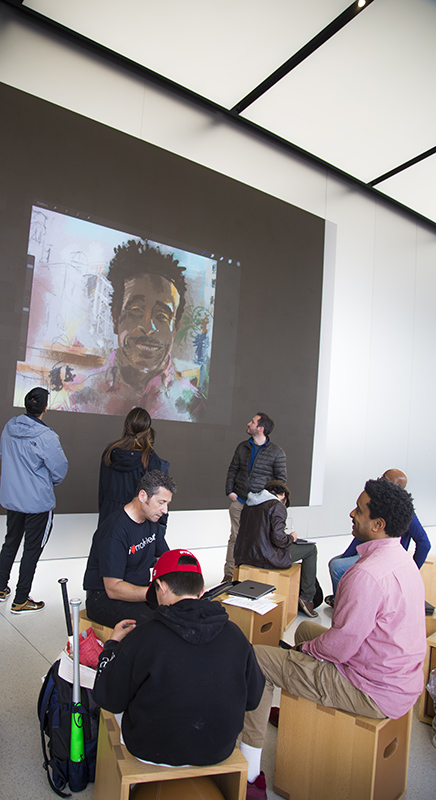

The iPad sketch below depicts New York-based artist Happy Menocal who I drew as she drew at the opening of the same Apple Store on May 21st, 2016 (see iMore article).
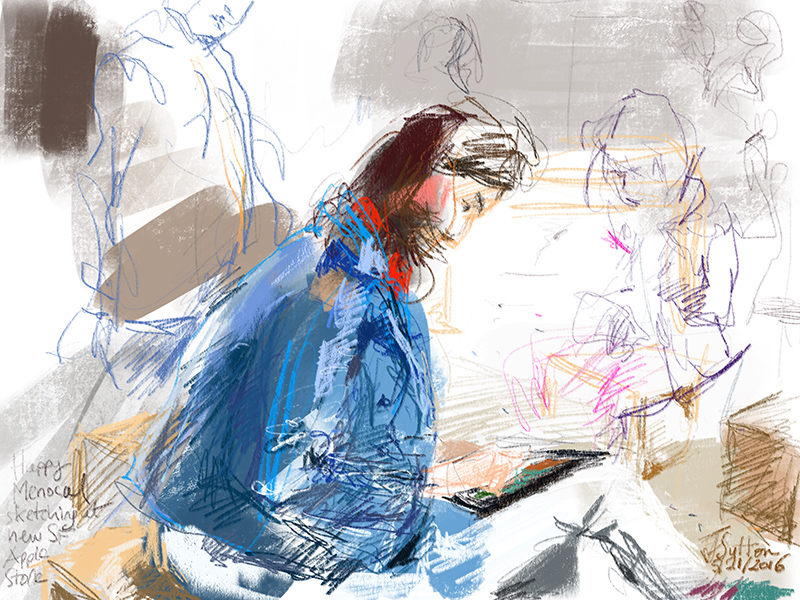
Here is the replay video showing how the drawing process of my portrait of Happy progressed from start to finish:
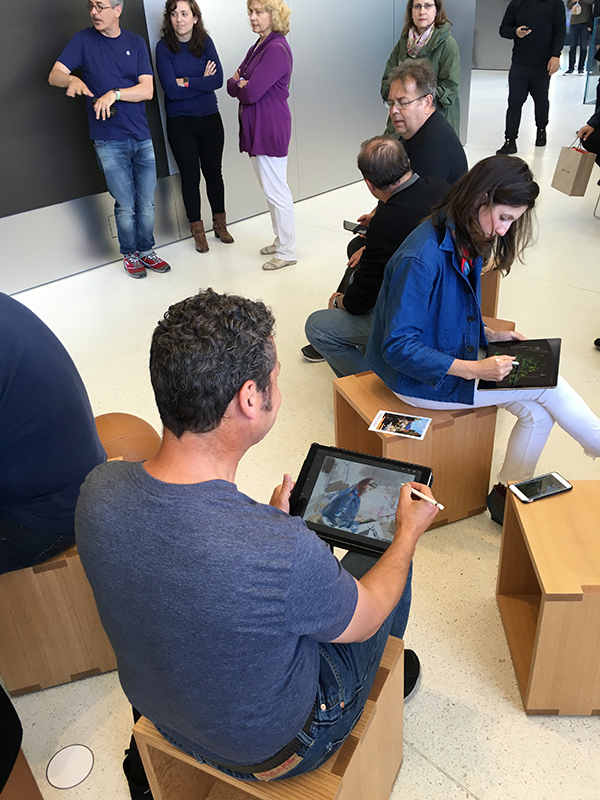
Photo above shows me drawing Happy as she draws. Her drawing is projected on the beautiful 6K screen they have in the Forum section of the store.
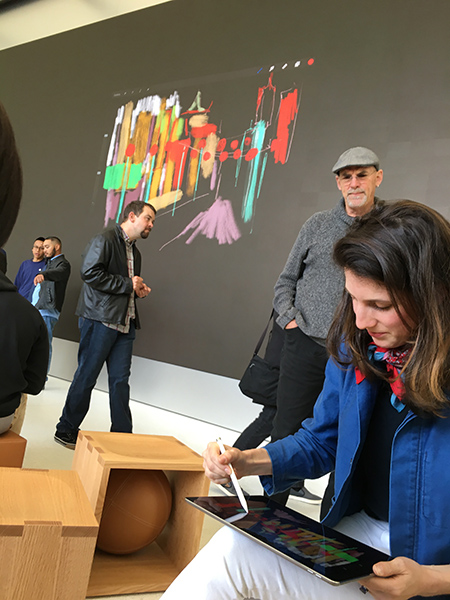
Here are some more photos from that day to give you an idea of the atmosphere and how amazing the new store is!
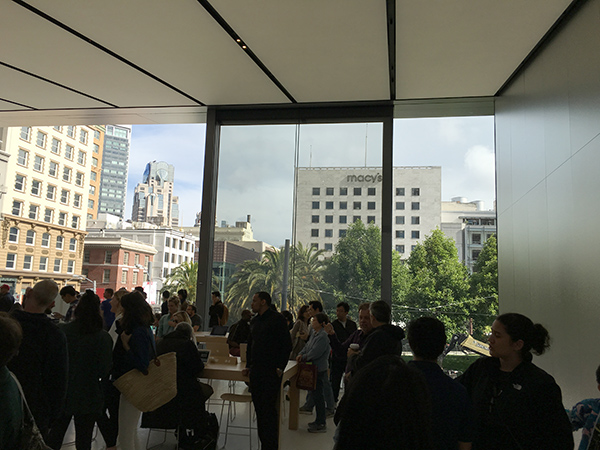
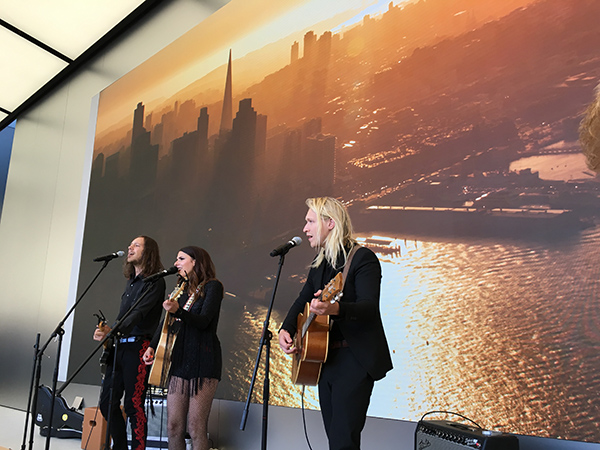


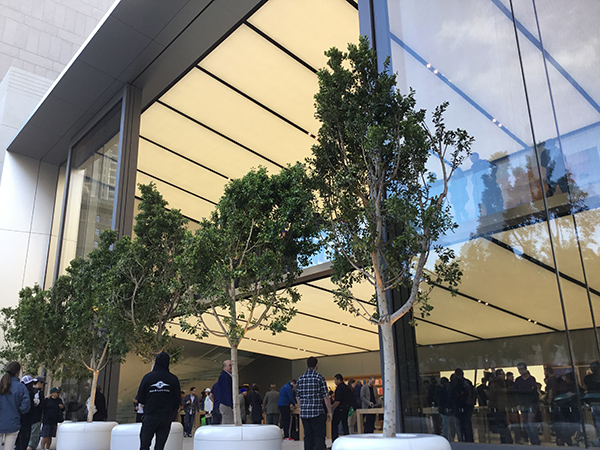
This photo shows the monumentally huge two-storey high glass doors slowly closing at the end of the day. A sight worth seeing!

As I walked away from the Apple Store that evening I looked back up Powell Street, saw a cable car pass me and took some reference photos with my iPad. Click here to see “Cable Car on Powell”, the painting I created based on those photos.
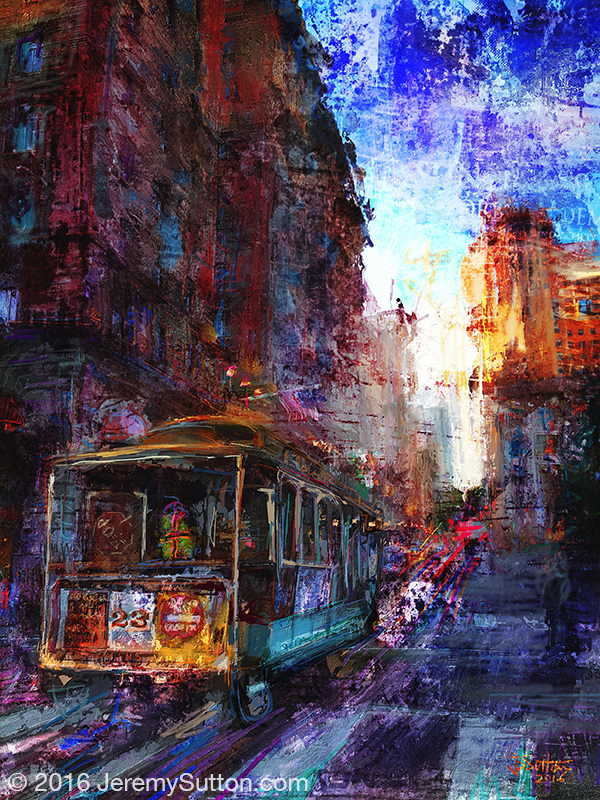
Jun, Jeremy Sutton, 2017, iPad Pro, Apple Pencil, Procreate
Parallel Play SF is a “fresh vision for collaborative, live music and art experiences” founded by artist Peggy Gyulai and violist Deanna Badizadegan. This performance was co-produced with TheGlint.com and included Peggy drawing on paper and painting on canvas, me drawing on paper (ink washes and oil stick) and on the iPad Pro 12.9″ (with Apple pencil and Procreate app). Deanna played viola, Karsten Windt played violin, and Angela Lee played cello. The music played was “String Trio” by Juan Cras followed by “Slow Cycles” by Danny Clay (world premier).
Thank you for an emotionally moving performance.
T.F. – audience member
Many thanks for so publicly sharing your art with us (and in real time no less!)
S.C. – audience member
Jeremy and Peggy, it was such a pleasure to work with you both, what a great project!
K.W. – musician



watercolor wash and oil stick on Arches cold press paper, 40″ x 26″, by Jeremy Sutton – created during the Juan Cras portion of the performance

iPad pro 12.9″, Apple Pencil, Procreate, by Jeremy Sutton – created during the Danny Clay portion of the performance

Peggy showing her painting to Dianna after working on it during the Danny Clay “Slow Cycles” performance
If you are interested in purchasing either of the artworks I created during this performance, here are the prices and options:
Traditional media ink wash and oil stick on Arches cold press paper, 40″ x 26″, $1,200 unframed
Pigment inkjet prints on canvas of the digital iPad painting, each individually printed in the artist’s studio and hand signed, stretched with gallery wrap, unframed, are available at these approximate dimensions:
24″ x 16″ $250
30″ x 20″ $500
40″ x 30″ $900
Other sizes available on request. To arrange a purchase please email Jeremy at jeremy@jeremysutton.com.

12″ x 9″ pen on paper, title page of Shultz’s book “learning from EXPERIENCE”, signed by author
This sketch was created at a wonderful talk George Shultz gave at the Commonwealth Club of California on February 21st, 2017, in San Francisco. The event was sold out so I sat outside the theater and watch it on live YoutUbe feed. As I watched I sketched his portrait in the front of the book, which he subsequently signed for me. I highly recommend the book! (And also all Commonwealth Club talks!)

The video above shows me live painting at Caroline and Mark’s wedding reception on board the magnificent Cabernet Sauvignon yacht, part of the Commodore Cruises & Events fleet that sails out of Alameda Island around the San Francisco Bay. It was a beautiful evening and, as you can see in the video, we had a full moon that rose behind the Bay Lights display on the Bay Bridge.
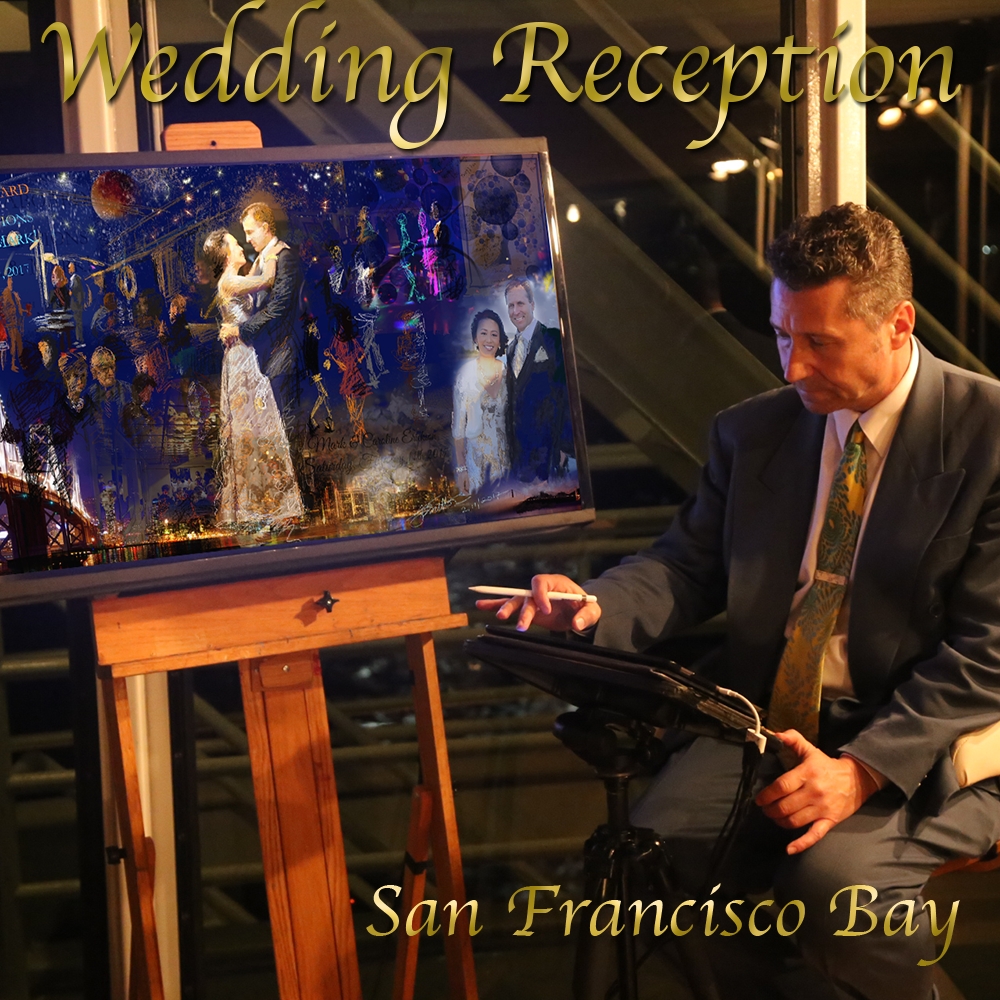
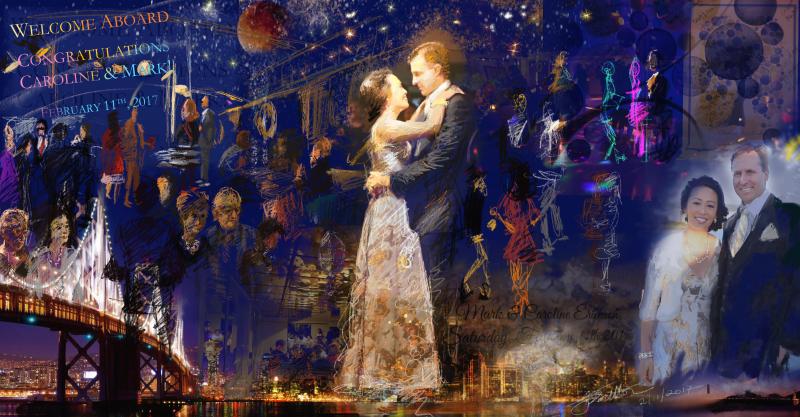
Jeremy Sutton, Caroline & Mark ~ Wedding Reception on the San Francisco Bay, 2017, iPad Pro, Apple Pencil, Procreate, 36″ x 18″
To hire me to paint at your wedding or any special event, please email me (jeremy@jeremysutton.com). You can see more examples of my live painting on the Live Event Painting page of this site.

Jeremy Sutton, Horszowski Trio at Kohl Mansion, 2017, iPad Pro, Apple Pencil, Procreate
This drawing was created on February 12th, 2017, from life during a concert of the Horszowski Trio, part of the Music at Kohl Mansion program that takes place in the beautiful historic Kohl Mansion in Burlingame, California. This trio will be featured again on February 25, 2024.The musicians featured in this drawing are, from left to right, Rieko Aizawa, piano; Jesse Mills, violin; and Raman Ramakrishnan, cello. They played works by composers Arthur Foote, Leonard Bernstein and Franz Schubert. I drew the whole time they were playing, roughly about 75 minutes. I started before they took to the stage and you’ll notice, if you look at the replay video below carefully, that I first draw in the piano with no one sitting at it and then the musicians arrive and I start to draw them over the piano…
Replay video showing how the drawing progressed from start to finish. This video is integrated into the final image as an Augmented Reality (AR) overlay. The AR overlay can be viewed using your smart phone (iPhone or Android) through the free AR app HidNFlix .
 The scene as I drew the musicians.
The scene as I drew the musicians.
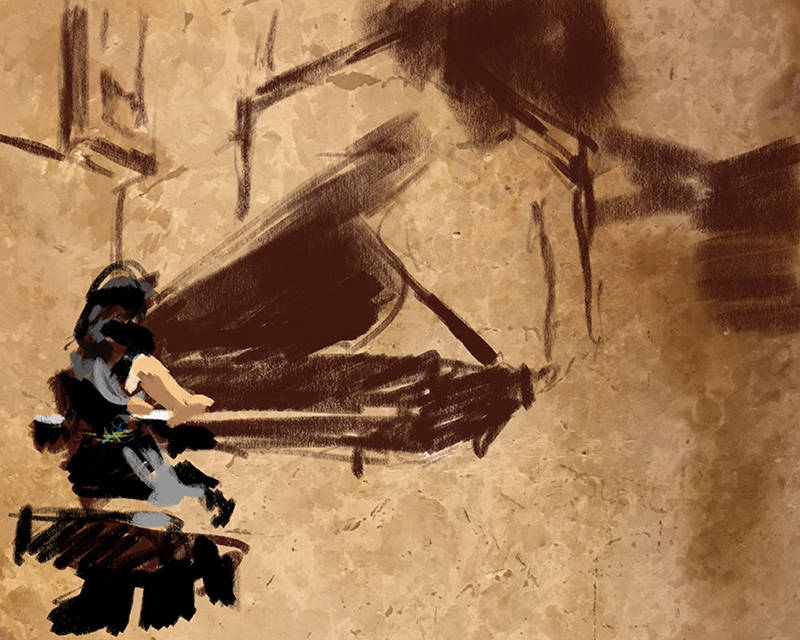 An early stage of the drawing.
An early stage of the drawing.
In 2018 I was the Painter-in-Residence at Music at Kohl Mansion. Click here for the June 2018 newsletter which includes some other of my painting subjects:
Miro Quartet
Israeli Chamber Project
Daedalus
Ying Quartet
Gryphon Trio